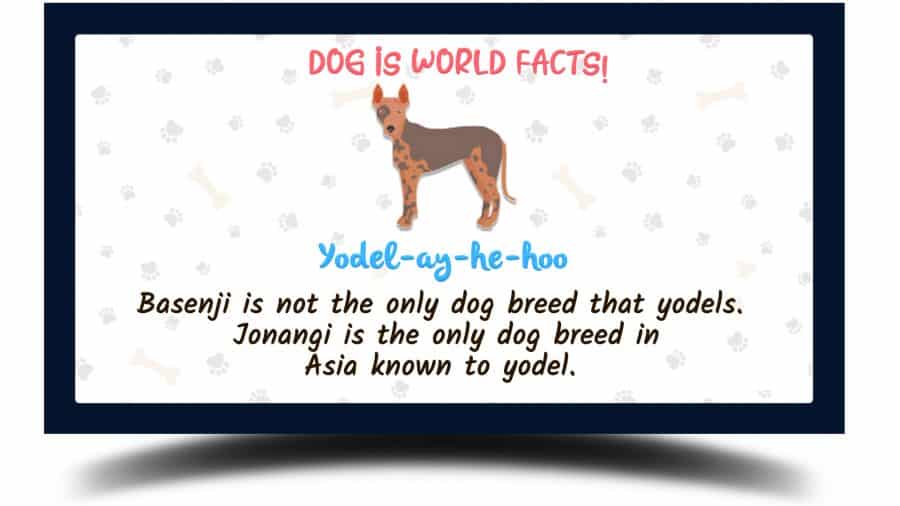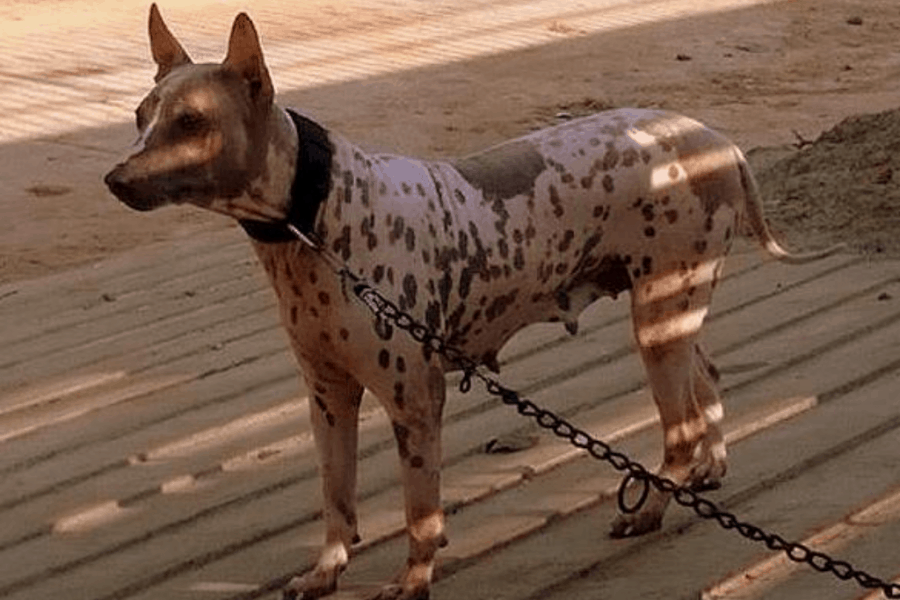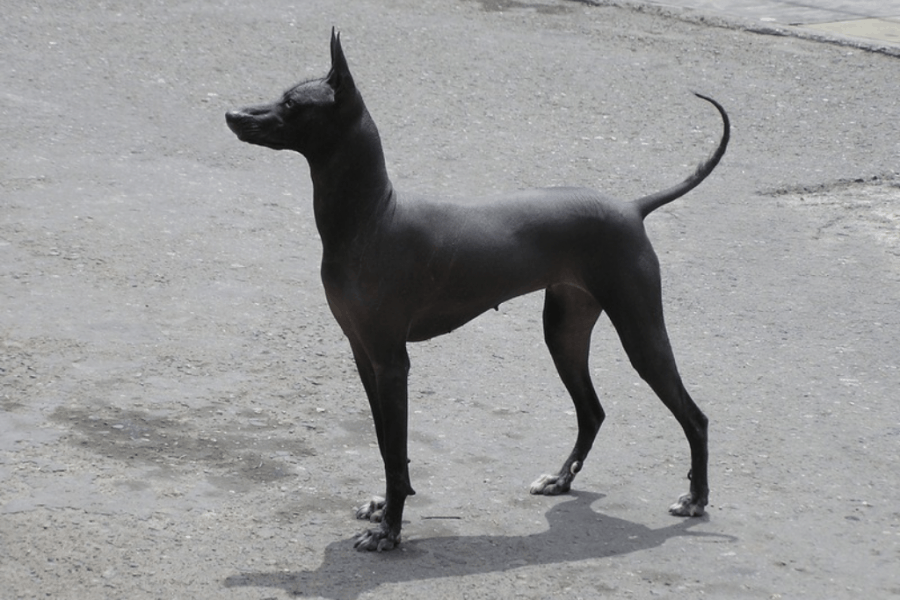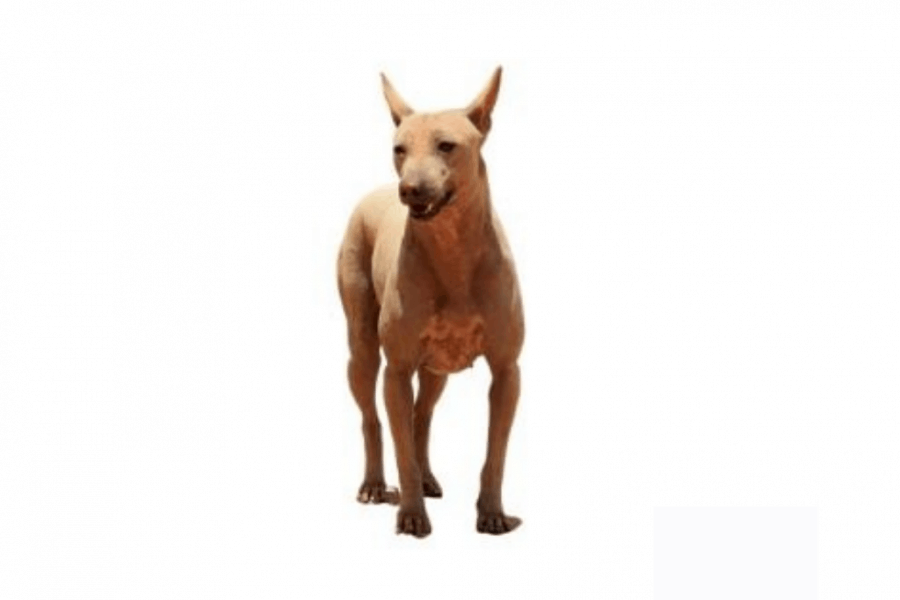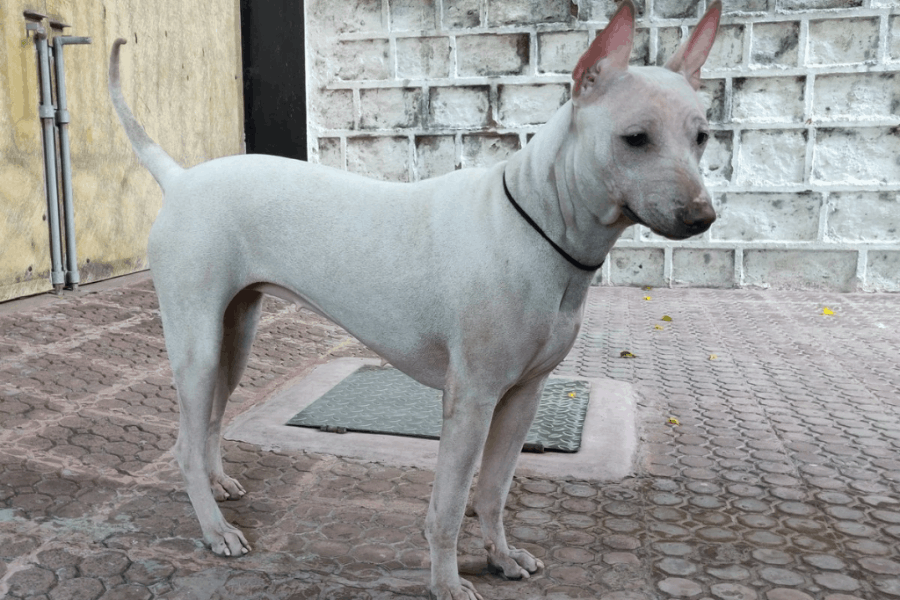The only humans that remind me of a Jonangi are opera singers. In terms of their voice and entertainment, they have a similar persona.
Bubbly and loyal, Jonangi is one pooch that everyone would love to keep. Although they are not considered an intelligent breed, their sharp instincts and impressive sense of smell make up for it.
It’s just like a saying “everyone is genius. You cannot judge a fish by its ability to fly”
They may appear to be small but they make a wonderful guard dog. This soulful breed is an extrovert who loves to make new friends. A Jonangi will shower love and affection to all its family members, especially children.
They live with only one motto “spread love wherever you go and make everyone happy”. Due to their study appearance and muscular built, the first thought that would come to anyone’s mind is to “RUN!!!” Although, they are very soft and gentle.
They are just like pineapples, they stand tall, wears crown like a king, and tough on the outside but sweet on the inside.
Interestingly, the face of a Jonangi resembles that of a pineapple. They have a very similar facial structure and are built like that of an English White Terrier.
Pat a Jonangi dog once and they are never going to stop trailing you. They just love cuddling and even when they grow up, they would always want to be on your lap.
Now let us roll over and find out more about this breed and educate ourselves before adopting one.
Note: The motive of DogIsWorld is to promote the revival and adoption of the endangered Indian dog breeds by writing this article. The in-fur-mation on Jonangi is very limited and we have tried our best to provide the most accurate details.
Did you know?
Jonangi is listed down as one of the most exotic dog breeds in the world.
Table of Contents
Quick Facts

Average Height: 17inches to 21inches
Average Weight: 12kgs to 21kgs
Dog Group: N/A
KCI Ranking: N/A
At A Glance
Jonangi is a medium-sized dog breed with a weight that withers between 12kgs to 21kgs. Male Jonangi has a weight between 18 to 21kgs while the female Jonangi dogs have a weight between 16 to 21kgs. Jonangi height is between 17 inches to 21 inches for both male and female dogs.
Being an Indian dog breed, they have a great immunity with a lifespan of 10 to 15 years. If brought up well and trained well, the 15 years will be filled with fun and happiness.
Jonangi is suitable for apartments as long as you fulfill their exercise needs. They were bred as livestock guardians and hunters. So, their chase drives are pretty high and they often need to run around to vent out their pent-up energy.
They are more suitable for apartments with an attached backyard or terrace available. Living in the countryside would be paw-fect for this breed.
Just like a Bull Terrier, they are friendly with their family and they love to please their master. They love cuddles and will do anything to get your attention. Jonangi is very paw-tective about their family members, especially children.
They are one of those dogs which can be trusted with kids. The maximum danger that they might cause is, licking around your baby’s face whenever they cry.
Early socialization will make Jonangi very friendly with almost all animals. If you have a pet bird, a pet cat, or another dog, Jonangi will mix very well with them, as long as they do not cause any harm.
Dog breeds with similar size to theirs like a Labrador Retriever, Bakharwal Dog, Corgi, Indian Pariah Dog, etc. will make a great companion. However, if they are left home alone for a long period, they might tend to get destructive.
Bark? Nah, our “dawg” Jonangi does not bark, rather yodels! They do not bark much but they do have a tendency to yodel whenever they want to go to play or when they are trying to alert their family.
Jonangi is known to have very low fur which makes them suitable for the summer and rainy seasons. They can have problems during winters and it would be better if you could provide them with some warm clothes.
Jonangi was bred to protect ducks from predators without any human interference. They are a very easy breed to train. They are known to obey the commands of their masters quickly and easily. Although, due to their below-average intelligence, it can be a little tough for them to comprehend a lot of commands. So, make sure you take it easy and slow.
Jonangi dogs have high energy levels and they love to play. They need 1 hour of play every day to vent out their energy. If you are unable to do so, be ready for your couch and pillows to be destroyed!
They love to dig up holes. So, if you have a backyard or a play-yard where they can dig up some holes, they would just love that.
Jonangi does not require much grooming as they have a very short coat. They were bred to withstand the gruesome heat of India with immense tolerance. They require an occasional bath with weekly brushing. Nail clipping, ear cleaning, and anal cleaning must be done when required. Teeth brushing just like we do ours must be done on Jonangi to avoid foul smell.
Jonangi dogs are Hypoallergenic. They have a very short coat and they do not shed. Although it is a myth that dogs are 100% hypoallergenic, there is a teeny-tiny paw-sibility that they might carry allergens.
Weekly brushing and taking extra care of them during their periods, also known as heat, will make your life easy and simple.
Jonangi dog price in India ranges from 12,000 INR to 20,000 INR. Since they are an Indian breed, they may be available at various rescue centers and animal shelters.
They are still available in a good range in the southern part of India, like Andhra Pradesh, Karnataka, and few parts of Tamil Nadu.
Did you know?
Eight known breeds in the world are fur-less and Jonangi comes on the top amongst those breeds.
About Jonangi
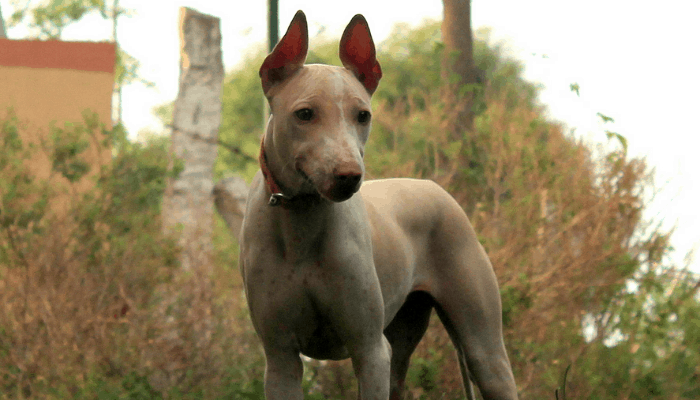
We all must learn one thing from a Jonangi and that is, “if you cannot eat it or play with it, just pee on it and walk away with your head high”.
Jonangi dogs are friendly dogs and they love to just cuddle. Infamous for their notoriety and mischiefs, if they are in a playful mood, they will “pull your leg”, literally. They have long legs with a lean torso and a glossy coat.
Quite like a sleeker version of an English Bull Terrier.
Jonangi has a facial structure that resembles the body of a pineapple. The most district feature of this breed is their pricky ears that resemble a tulip. Their forehead is a bit wrinkly with eyes like two sparkling sapphire gems.
Usually, a Jonangi has a tail of medium length which is curved like a whip at the end. Their short muzzle and squat face make many people mistake them for a fox.
Just as the saying goes, “good things come in small packages”, Jonangi is a medium-sized breed with a height that withers between 17 inches to 21 inches for male Jonangi dogs and 16 inches to 21 inches for female Jonangi dogs. Feather-weighted breed, they have a weight that withers between 12kgs to 21kgs for both male and female Jonangi dogs.
A Jonangi is suitable for a one-person relationship and family settings as well. They are very awe-fectionate towards their family members but being guard dogs, they can be wary of strangers. Although, they are not known to show aggression unless they are provoked.
Make sure you give this breed plenty of exercises as they like to be busy throughout the day. They do not like to be left alone for a long stretch of days and they can get panicky. Being around energetic and active people, they love to play and jump around. Restricting their activities can lead to destructive habits and we do not want a “bad boi” do we?
Encouraging Jonangi while they are playing and exercising can take you a long way. Paw-sitive reinforcement techniques are known to be the best way to train them. They are not a very smart breed and they can take time to comprehend many commands but patience is the key here.
Suggested: Best indoor games for dogs
It is very easy to train a Jonangi as they are here to please their master. If you have another dog at home, make sure you make them friends from the very beginning itself. Big dogs such as Great Danes or Chippiparai are bad options along with this Andhra dog breed.
Cats and other small pets are also equally compatible with this breed. Early socializing is the key here after which they are known to be good friends with almost all pets.
Sadly, now they are on the verge of extinction. They are not recognized by any major kennels and also, they do not have much exposure like other breeds. Thanks to Theodore Baskaran and his book, “The Book of Indian Dogs”, the revival of the Jonangi dog breed has started again.
History
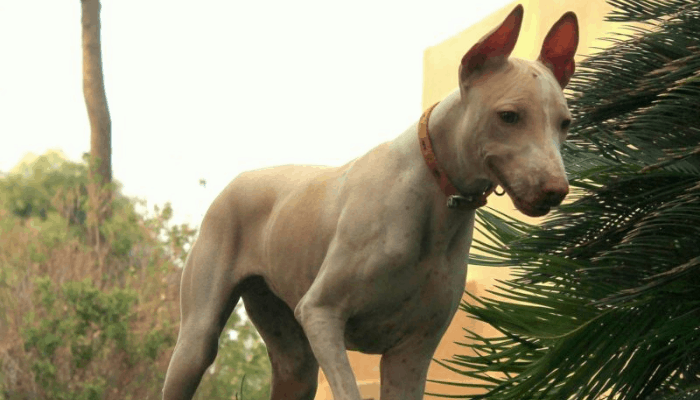
The exact origin of Jonangi is bizarre. They were ideally bred for hunting and herding by the duck herders. They were found in the Nellore district near Kolleru Lake in the West of Godavari and Krishna lakes in Andhra Pradesh. That is how it got the other names “Jonangi Jagilam” and “Kolleti Jagilam”.
The duck herders used to move around the Pulicat lake and Kolleru lake along with Jonangi to save them from the predators. They were abundantly found in the coastal areas of Andhra Pradesh, Karnataka, Tamil Nadu, Maharashtra, Goa, and West Bengal.
Since the duck herding went out of fashion and was seen as a livelihood anymore, aquaculture was seen profitable, Jonagis were left in vain. Left with no job to do and the humans not taking care of them, they resorted to “survival of the fittest” where they developed a unique technique to hunt fishes by digging a hole.
So smart, aren’t they? Here some people consider them as below-average in intelligence.
Now, as they started to adopt this lifestyle for survival, the same farmers who bred them from protection, considered them as a nuisance and as pests. Their smart fishing strategy was then seen as trouble for the farmers as they were going in a loss which leads them to a killing spree. Many of the Andhra Pradesh dog breed was killed and the entire breed of Jonangi was limited and lead to extinction.
Now, the Asil breeders (Asil or Aseel is a breed of chicken) and many other farm owners in Andhra Pradesh and Tamil Nadu are realizing the importance of the breed. Nowadays, Jonangis are kept as guard dogs and watchdogs to help the breeders and farm owners protect their livestock from predators.
The revival of this breed has increased substantially and now they are in a decent number in Nellore district and few regions of Tamil Nadu.
Did you know?
Local dog shows at beach festivals are promoting Jonangi to generate interest in this Andhra Pradesh dog breed amongst us Indians to preserve this breed.
Facts Theatre
Parenting and Guide
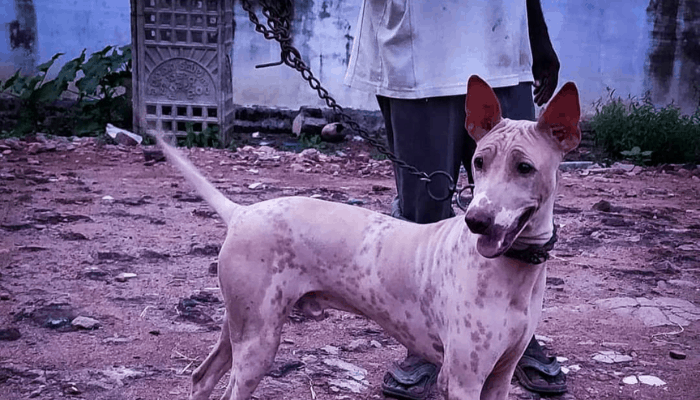
Namaskar
Jonangi dogs are very courageous, bold, and social. They are very compatible with almost everyone and everything. They need to be socialized from a young age as they are guard and hunter dogs.
If they are not exposed to different sounds, sights, experiences, and hooman, they might end up barking at almost anything.
Paper, snow, a ghost!
Training a Jonangi dog is very easy. They are innovative and they might just surprise you how creative they can be. Even though they are considered as a below average in intelligence breed, they can pick up commands very fast.
They are slow at picking up a lot of commands at once. So, patience is the key here, and teach them commands one at a time.
Family Guy
When you get a Jonangi, you will see that they are an ideal family pet. They are very compatible with children; they are compatible with old people and they are also excellent guard dogs for people who have low hearing problems.
People who have high energy as theirs will become their best friends. They enjoy the attention and they love to get pampered.
Winter is coming
Being an Indian breed, they are accustomed to all the weather around. Although, the short coat makes them vulnerable and exposed to cold climates. They would prefer it if you can provide them with warm clothes.
Dig A Hole For Yourself
After being abandoned by the duck herders, the Jonangi dog breed started to dig a hole and capture the fishes as they cannot swim well. Since then they have started to dig holes and it is still there in their genes.
So, if you have a backyard, then your pooch might want to sleep there, and also that would be their go-to spot.
Puppyhood Training
Even though we have established the fact that training a Jonangi is easy, training them from puppyhood is a must. They are courageous, bold, and naughty, so training them from puppyhood will create a better bond between the two of you. They will also start listening to quicker and often.
They have their own will and are pretty independent. Although, support from the owners will make them feel loved. They also tend to do a particular job better if paw-sitive reinforcement techniques are used.
Personality and Temperament
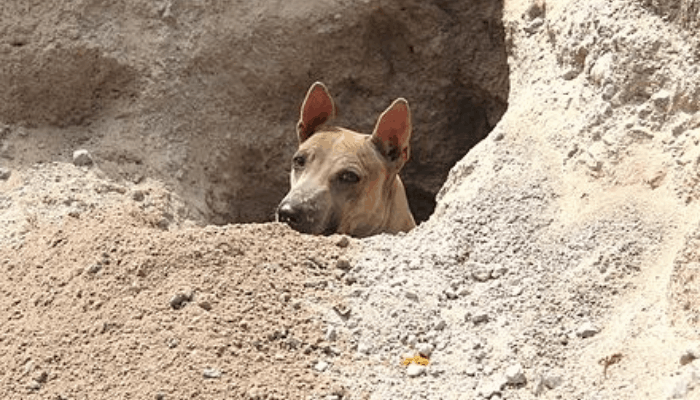
The purr-fect companion dog, Jonangi, are extremely affable and loyal. They get acquainted with their family members in no time. They are wary of strangers and might not like to get petted by them unless told by their masters.
Other than Basenji, this is the only other breed that is known to yodel. Jonangi does not bark a lot and mostly yodels. This a bit hard to comprehend for most of the dog owners as they always wonder if they are in pain or they are sick. Although it is quite normal and pretty comical if I might add.
There are hardly any YouTube videos available as the breed was in extinction, but we have found a couple of them. Watch these videos of Jonangi pups yodeling and Jonangi pups playing around.
Bred to paw-tect the ducks from predators, they can be aggressive against big dogs if their training is not done well. During their puppyhood, make sure they are well acquainted with almost all kinds of animals. This will make them subtle toward other animals.
They are suited for both one-person relationship and even a family. They do very well with children and can be their protectors as well. They can be quiet with strangers around but do not attack them or charge at them until they are provoked.
One of the hallmark points of a Jonangi is their stamina. Until a few years ago, they had to hunt and fend off enemies themselves which made them travel long distances with long strides.
If this would be your fur-st time owning a Jonangi, do not worry about anything as they can be easily dealt with. They make an ideal dog for first-time dog owners. Since they are always eager to please their masters, they make wonderful house pets.
Jonangi dogs love to play and exercise ad if you love to exercise and jog around, this would be one of the best breeds for you. Running on a large field with full strides and draining out their energy is the most ideal way for them.
If you are going to be out most of the day, make sure you keep Jonangi in a fenced backyard so that they can play whenever they want. Although, make sure you take them out for a jog whenever you come back home. The owner-dog bond is very important as better the bond, better the trust, and better the trust, quicker response to commands.
Sometimes, Jonangi might become a little sensitive. Scolding them for everything they do wrong will make them aloof. Positive reinforcement techniques will always work like charms. Also, do not train them in a crate as they might get ferocious. Leash training since puppyhood is important so that they can be controlled if they get aggressive.
Did you know?
Jonangi is known for its agility. They can dodge and weave in dense underground terrain without any difficulty.
Colors and Grooming
Indian dogs in general are very low maintenance and economical. If at all you adopt them, they are free of cost and the only additional cost will be for the basic grooming.
Jonangi breeds are nearly furless and they seldom shed. They do not need any professional grooming but a shower after they get dirty.
Occasional showering with weekly brushing is required to maintain their hygiene. Brushing not only removes all the allergens that you might be allergic to but also will regulate the blood flow within them.
Routine maintenance of ear, eyes, and anal cleaning must be done along with nail clipping. Do brush their teeth just like we brush ours to avoid tooth decay in the future.
Look out for foul breath and if at all if their breath smells like urine, you Jonangi could be suffering from kidney issues.
Feeding A Jonangi
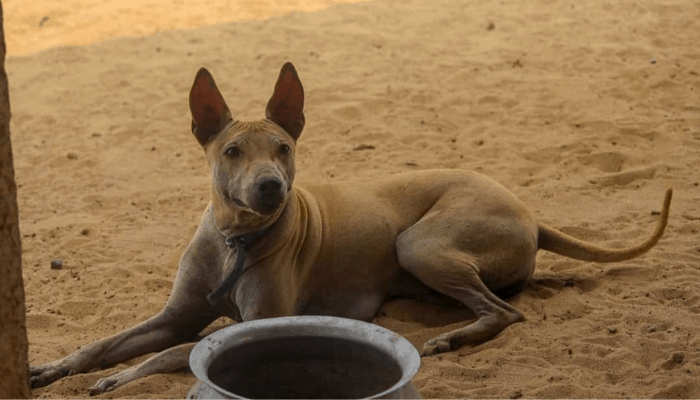
Living in the streets with duck herders and then living off alone, they are immune to practically all kinds of local food. Being able to digest any kind of homemade food would be perfect because not only they enjoy it but it will also be economical.
Jonangi loves to eat all kinds of food but fish is their most favorite. Although, the paw-fect diet that we must include in their diet to make them healthy and vicarious is a plan of 50% carbohydrates depending upon the height and weight which includes 4% to 5% fibers, 30% proteins, 10% vitamins, and 10% minerals.
Note: Feeding your pooch Onion and Garlic will act as a poison. So do not include them in your diet. Chili can act as cyanide for your pooch and many dogs have faced immense issues. So be careful before you give anything.
Suggested: Toxic food for dogs
A) Puppy (8 weeks to 6 months)
A Jonangi puppy dog needs 3 cups of high-quality and nutritious food, thrice a day. Instead of giving calcium tablets, the calcium needs can be fulfilled by giving your pup milk. Do ask your vet about the suggestion and see what else can be done.
The perfect diet for a Jonangi pup is giving them about 64gms of rice (1/2 cup) with 1/3rd a cup of milk along and little cut fruits. This will suffice their quality intake for 1 meal.
Feeding them roti/chapati is fine as long as we mash them or grind them a little. Mix the ground roti or chapati with milk or chicken broth to make a paste.
If the food quantity is low or high, do not increase/decrease them drastically. That might affect them. Increase or decrease it by just 20gms and not more than this.
B) Adult (14 months to 5 years)
Once your pooch has reached adulthood, they require some good amount of proteins and nutrition. You can still feed them 3 cups of high-quality and nutritious food, thrice a day.
You can now give them either 10 to 15 chapati/rotis in their diet along with a green vegetable, say, spinach, broccoli, or fenugreek/methi and so on.
The best meal would be giving them 64gms of rice (1/2 cup) with 30gms of “boiled chicken” without any masala and a small number of green vegetables. You can also give 1 boiled egg in an entire day.
C) Senior Dog (9 years and above)
Once Jonangi has entered the senior/old dog stage, you can reduce their servings or keep their servings thrice a day with reduced quantity. Since they do not exercise much, we wouldn’t want to overfeed them.
When you give your pooch their diet, look for the signs of obesity. If at all you notice such signs, do stop the diet immediately and take them to your vet and shift them to a senior dog food diet.
Health and Vaccination
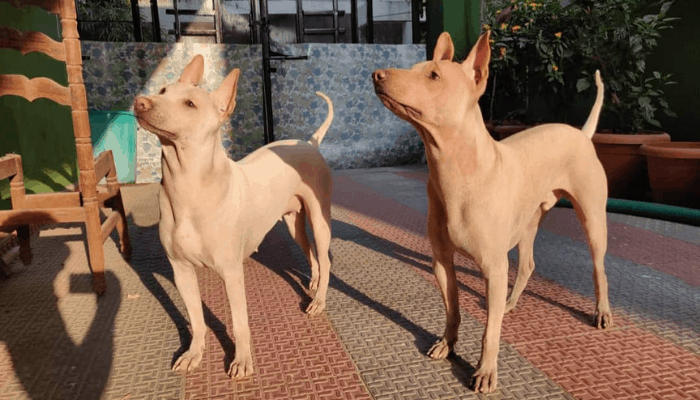
The majority of the dog owners have mentioned that Jonangi’s health is robust. They are used to living in harsh circumstances and they do not have any inherited diseases. Even so, there are a few common dog illnesses that they might face which is better to know and understand.
1. Arthritis
Arthritis is an inflammation in the joint which is, unfortunately, a common problem amongst dogs. This not only causes pain and discomfort but in the worse cases makes them bed-ridden and unable to walk for a long time.
The cartilages within the joints rub against each other after they are damaged, causing friction in the joints. Increasing friction causes newer bones to forms around the area which causes stiffness and difficulty in moving (also known as a degenerative joint disease).
The signs that develop after Jonangi has this problem are straightforward and not at all difficult to find out. The symptoms are:
- Difficulty in exercising
- Saliva staining at joints
- Stiffness in joints
- Limping
- Slower movement than usual
Your vet can recognize the symptoms by the pain that is caused or by discomfort caused in that area. They examine the discomfort by joint extension and joint flexion. In some cases, an x-ray might be needed to examine thoroughly. Few treatment procedures are:
- Cartilage protectors are provided to reduce the cartilage damage and promote the repair of joint structures
- Due to overweight, arthritis is a possibility. So, the reduction of weight is another way to reduce the stress on joints.
- Anti-Inflammatory medicines are provided for the short-term as a pain-killer for inflammation is sought out. Although, using them regularly for medium- or long-term use can be dangerous.
2. Ear Infections
One of the most common problems for dogs is an ear infection. It is an average estimation that about 20% of dogs have some form of infection in their ears. To stop these episodes, you must be careful and observant to identify the issue and resolve it as soon as possible.
Some several causes and factors may act as a catalyst for an ear infection amongst dogs:
- About 25% to 30% of the time, ear infections are caused because of allergies. In this, about 50% of the dogs suffer from skin allergies and 80% suffer from food sensitivities.
- The difference in moisture that can trigger the growth of bacteria and yeast
- Building up of ear-waxEar canal is injured
When a Jonangi faces ear infections, there are many symptoms that you must keep in mind. Other than wax buildup and ear discharge, Jonangi does not show any kind of symptoms. Here are a few of the symptoms that you can keep in your mind:
- Rapid shaking of their heads
- A dark-ish discharge from their ears
- A pungent odor
- Excessive itchiness in their ears
- Pain or discomfort in their ears
Besides the gentle palpation in the ears to check the discomfort, your vet might take biopsies and samples collected from their ears through a cotton swab. Few of the treatment methods are:
- Thorough ear cleansing using a medicated ear cleaner.
- Topical medicines for you to use at your house
- Antibiotics and anti-inflammatory medications are given in the worst-case scenarios
- On the most severe note, if all the treatments fail, your vet may suggest you perform a surgery where they will remove the ear canal and thus removing the diseased tissue.
You can always prevent such diseases by taking precautions. Always dry your dog’s ear after the go for a swim, bath, basically whenever their ears are exposed to water. If ear infections are chronic, it could be because of an allergy. Ask your vet for the reason and alternative.
3. Lower Urinary Tract Diseases
This is a very rare condition amongst dogs with only 3% to 4% being affected. This issue affects dogs that 5 years and above more than the dogs at a younger age. Older female dogs with diabetes are the most affected by this problem.
When Lower Urinary Tract affects Jonangi, the main causes are:
- Stones in the urethra (or bladder)
- Inflammation in the bladder
- The weakening of the bladder
- Stress
- Prostate diseases
There are a few ways that are detectable to find out your pooch is facing an issue. The symptoms are:
- Blood coming from the urine
- Fever
- No bladder controls. This results in dripping urine throughout
- Constant licking at the urinary opening
- Change in appetite
- Vomiting
Since the Urinary problems of Jonangi vary from gender and also differs from various canines, the immediate step is to show them to your vet. Since the disease is potentially dangerous, your vet may make a diagnosis and one of the following treatments may be recommended:
- Antibiotics
- Depending on the severity, medications or supplements can be given
- The vet may suggest you increase the water intake
- In the case of stones present, surgery can be conducted to remove the stones or tumor
- If there is diabetes, treatment of this underlying disease is done to make the urinary tract better
An untreated Lower Urinary Tract Disease (LUTD) is very dangerous. It can cause medical problems adding as a catalyst to the current problem. If the bladder infection moves to the kidney, it can be life-threatening. So, take note of the signs without failure.
Vaccination of Jonangi must be done with utmost care. Make sure you give them Canine Parvovirus. Canine Distemper must be given 5 times respectively from the age of 6, 8. 10, 12 and finally at 16 weeks. Do inquire with your vet about the Canine Deworming Vaccination plan as it is a must!!
For more information, you can check out this detailed vaccination guide. This will help you to understand everything about vaccination so you can be confident about getting your pooch one.
Frequently Asked Questions
Jonangi is still available in the Nellore district of Andhra Pradesh. You can also contact various animal shelters and animal welfare organizations in your neighborhood. There is a possibility you might be able to find one there.
Since they are under extinctions, the breeders might sell you Jonangi at a very high price. You can also contact Mr. Venkata Ramana Pasila who is a welfare activist. He still breeds pure Jonangi breeds where you might be able to get a Jonangi dog breed.
Training Jonangi is very easy. They are a breed that is always eager to please their master. They are very bold and courageous at the same time naughty. Start training them from their puppyhood.
You can go for a jog, go for long walks, and expose them to various sights, sounds, humans, and different experiences that are around. Create a good bond between the two of you so that they can develop trust in you. Make the training exciting so that they enjoy playing with you and when you play along with them, you can understand them better.
Always support your Jonangi dog in such a way that they are motivated. Punishing them all the time can make them more aggressive and they might lose confidence. One of the best ways to train your pooch is positive reinforcement training.
Jonangi dogs or Jonangi Jagilam/Kolleti Jagilam are not at all aggressive. They are very sweet and family-oriented. They are extremely friendly with their family members including babies. They might be a bit wary of strangers but they do not bark until and unless they are provoked. Jonangi dogs might also become aggressive if they are put inside a crate for a long amount of time.
Socializing them from puppyhood will make them compatible with other dog breeds and sometimes even cats. Due to their hunting instincts, they might get go out of control but if you train them well, you can help them control themselves.
Jonangi dogs are almost furless and they do not shed. Although, there are certain factors which make them shed a little. This could be due to poor grooming or not taken care of properly and in some cases, it could be because of skin infection.
Moreover, Jonangi dogs or Jonangi Jagilam/Kolleti Jagilam are hypoallergic. It is a myth that dogs can be 100% hypoallergenic. There is a possibility that they might carry some allergens with them but that can be taken care of by regular skin brushing.
Similar Breeds
Greetings!
This was all about the Jonangi! The research on this breed was very limited and there is a lot more we have yet to discover about Jonangi.
If anybody owns a Jonangi, do let us know in the comments below how your first-hand experience was in handling them. Also, if you do have any queries do let us know and we will provide you with the best solution that we could up with.
Sharing this article on Whatsapp, Instagram, and Facebook will help many people and friends who are stuck in a dilemma.
We update our YouTube channel regarding other breeds regularly. Subscribe to our channel to know about it.
Follow our Instagram channel dogisworldcom for a daily doggo-licious content
Happy Woofing!








